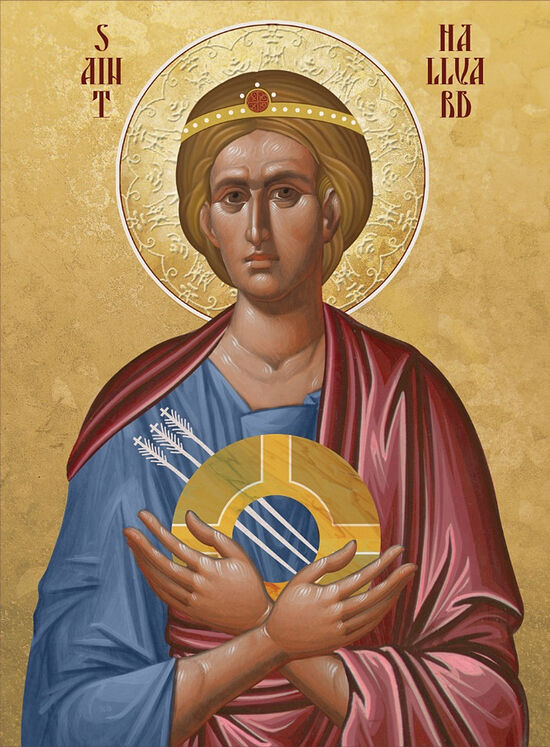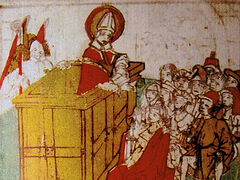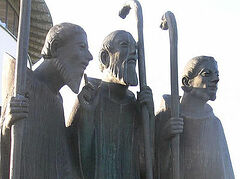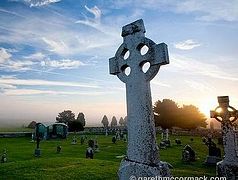Part 1: Introduction, Missionaries and Enlighteners
2. Holy Martyrs:
St. Sunniva of Selje (†10th c.)
St. Hallvard of Husaby (†1043)
A pair of holy martyrs, both associated with Norway, graced the Nordic lands. If, as has been truly stated, the blood of martyrs is the seed of the Church, then the Church in the Nordic lands as planted by Sts. Ansgar and Sigfrid was abundantly watered by the precious blood of these great witnesses for Christ.
 St. Sunniva of Selje, patroness of Bergen
St. Sunniva of Selje, patroness of Bergen
St. Sunniva of Selje Island, Norway, is the heavenly patroness of the city of Bergen.
She was an Irish princess born sometime in the 10th century. Her name, rather poetically, means “sun-gift.” It is said that, while still a youthful maiden, she fled when a pagan king, intent on taking her as his bride, invaded her kingdom. She, her sainted brother Alban, and some companions embarked on a little boat without oars, committing their destiny entirely to the will of God in much the same way as St. Brendan (†c.577) had done centuries before.
They arrived at length at the island of Selje off the Norwegian coast. There they settled in a cave and lived monastically. But the enemy of mankind stirred up enmity against them among the local pagans. The chieftain Haskon Jarl suspected the company of having stolen some sheep and used this pretext to make an expedition against them. Seeing their approach, and fearing lest she might fall captive to and be defiled by the infidel men, St. Sunniva with her companions took refuge in their cave. There the pious maiden prayed fervently that God would preserve her in purity. At once the cave collapsed upon them, sending their souls to eternal glory.
But, much like the Seven Sleepers of Ephesus from ancient times, the sanctity of these holy martyrs (for such they were) could not be hidden forever. Mysterious otherworldly lights were seen by many above the cave that entombed them. Such was the attention this generated that King Olaf Tryggvason came personally to investigate. There, in the presence of the holy bishop St. Sigfrid (see above), the miraculously incorrupt holy relics of St. Sunniva were recovered.
An abbey was built on Selje near the site of St. Sunniva’s repose. In the latter part of the 12th century, her wonderworking relics, glorified by many miracles of healing, were transferred to Bergen. There her grace-filled help was manifested numerous times. Twice her relics halted the advance of devastating fires. Thus forever after the holy virgin martyr Sunniva has been revered as the patron saint of that city, and remains one of Norway’s most beloved saints.
 St. Hallvard of Husaby, patron of Oslo
St. Hallvard of Husaby, patron of Oslo
Just as St. Sunniva is forever revered as the patroness of Bergen, St. Hallvard of Husaby is, to this day, considered the patron saint of Oslo, Norway. His parents were well to do farmers. His mother, it is believed, may have been a relative of the martyr king St. Olaf Haraldsson (below). As a young man, St. Hallvard protected a pregnant bond woman who had sought refuge on his ship. She was being pursued by three men who had accused her of theft. The men killed her and St. Hallvard with arrows. Tying a millstone about St. Hallvard’s neck, they attempted to dispose of his body in the Drammensfjord, but miraculously it would not sink. St. Hallvard came to be venerated as a martyr; his image even now adorns the seal of the city of Oslo, Norway’s capital.
Through Sts. Sunniva and Hallvard, the Nordic lands (Norway in particular) are blessed with martyr saints to serve present day Orthodox Christians in the region with examples of perseverance in service to Christ no matter the cost, and to serve as powerful heavenly intercessors for the return of the Nordic lands to their Orthodox heritage.
3. Royal Nordic Saints:
St. Olaf the Swede (†1022)
St. Anna of Novgorod (†c.1050)
St. Olaf II Haraldsson, King of Norway (†1030)
This section will examine the lives of three royal saints of the Nordic lands, featuring some of the most outstanding personalities and most luminous examples of holy rulership from the entire long and venerable Orthodox history of Western Europe.
St. Olaf the Swede (not to be confused with either king Olaf Tryggvason or St. Olaf Haraldsson of Norway) was the first Swedish king to accept Christian baptism. As such, he is a watershed figure in the nation’s history and one of the spiritual fountainheads of its sacred patrimony. He is also known as Olaf Skötkonung. The various alliances, expeditions, and battles of his life before his conversion are not of direct interest to this discussion. What is significant is the fact that it was he who summoned St. Sigfrid to re-enlighten his lands, and he in turn eventually accepted baptism at the saint’s hands. St. Olaf the Swede proved a zealous Christian and remained loyal to his newfound faith throughout the rest of his life. He desired to tear down a major pagan shrine in Uppsala, but the idolaters were still too numerous and powerful for him to accomplish his commendable desire. Instead, of necessity he adopted a less coercive approach to the conversion of his people. However, he continued to face sharp pagan opposition to his Christianization efforts, and eventually suffered martyrdom at Stockholm in the year 1022.
St. Olaf’s daughter, St. Anna of Novgorod, is one of those remarkable figures who link the Orthodox Church of the West with the Church in the East, reminding us of our common heritage.
 The right-believing princess, St. Anna (Ingegerd) of Novgorod
The right-believing princess, St. Anna (Ingegerd) of Novgorod
St. Anna was named Ingegerd at birth. With her father and the entire royal court, she was converted and received baptism at the hands of St. Sigfrid at Husaby.
Princess Ingegerd (who received the name Irina in baptism) was given in marriage in the year 1019 to King St. Yaroslav the Wise (†1054). She thereby became Grand Princess of Kiev. Using her considerable natural gifts and great intelligence, she played an active and influential role in her husband’s administration of the kingdom’s affairs. She played an especially important role in cultivating relationships with Northern Europe, her own native territory. She also received refugee royals from England, Edward and Edmund Ætheling (who were fleeing the Danish King Cnut), again demonstrating the close East-West ties of that time.
The period of her and St. Yaroslav’s rule was a spiritual high point in the history of Kievan Rus’. Among other blessings, it saw the start of Russia’s great monastic tradition with the arrival from Mt. Athos of St. Anthony, founder of the Kiev Caves Lavra. It was also a time of cultural achievements and political stability and consolidation. Irina herself was highly educated, being widely read in diverse subjects, including the Scandinavian sagas of her homeland.
Grand Princess Irina gave birth to ten children in all, who were characterized by holy lives. One of them was Prince St. Vladimir of Novgorod. Later in life Irina entered monastic life, receiving the name Anna at tonsure. She thus established a pious precedent among Russian royalty of retiring to a monastery or convent after one’s time of service to state had passed. She reposed peacefully in 1050-1051, in the St. Sophia Cathedral in Kiev.
We see in St. Anna’s life as if in a nutshell the universal reach of our Mother Church. The Orthodox Church is and has always been unbounded, transcending all national and ethnic borders (without, though, obliterating or abolishing them). St. Anna shows this dramatically: A Swedish princess, she was evangelized by an Englishman and married into Russian royalty, in which place and role she became a saint. Truly, God is wondrous in his faithful servants, of which she is a shining example.
 The holy king-martyr St. Olaf Haraldsson of Norway, patron of Scandinavia
The holy king-martyr St. Olaf Haraldsson of Norway, patron of Scandinavia
Another outstanding holy ruler, and one of the most beloved of all Nordic saints, is King St. Olaf Haraldsson of Norway. King St. Olaf is especially beloved for his martyric death on the field of battle as he fought to defend the Christian faith, and for his efforts to unite the Norwegian land. Indeed, he is considered the patron saint par excellence of all Norway.
St. Olaf received baptism in Rouen in the Normandy region of northwestern France in the year 1010, having been first exposed to the Christian faith in England. Upon ascending the throne of his native Norway, he vigorously attempted to root out the inveterate paganism of the land and firmly plant in its stead Christian piety. To this end, he imported many clerics from England, Normandy, and Germany. (Indeed, he is thought by some to have made much use of Norman clergy as they were familiar, being fellow Northmen, with Nordic culture and ways). Pagan temples and shrines were demolished and churches built in their place, so that the very places where demons had long been slavishly served in wicked and profane rites resounded instead with hymns to the Lord Jesus Christ.
Intense pagan opposition to his religious policies ultimately forced him into a period of exile. The holy monarch spent time in Sweden and in Kievan Rus. Returning at length with an army to try to reclaim his throne, he met his pagan opponents at Stiklestad. There he fought valiantly but fell, a martyr for the evangelization and unification of his people. His dying words were, “God help me.”
King St. Olaf’s relics remained incorrupt and miracles quickly became associated with them. His shrine in Trondheim thus became a focus of pilgrimage. This played a significant role in the Christianization of the Norwegian people. St. Olaf thereby accomplished through his death the great task he had been unable to realize during his life. He was also crucial in establishing the Christian faith in Iceland and the Faroe Islands. Veneration of him soon spread throughout all of Scandinavia. To this day, he is venerated throughout the region as one its foremost heavenly patrons, and many locations are named for him.
These great royal saints of the Nordic lands, with their powerful and fearless witness for Christ, demonstrate a courage much like that of the missionaries and martyrs of the region. Indeed, that native courage in the face of any and all difficulties and dangers is one of the most salient and admirable historic Nordic traits, and it shines through in every category of the area’s saints. The royal saints are brilliant examples. They forever stand as inspirations to all believers and as bold heavenly intercessors for their people to this very day.
4. Present Situation and Conclusion
Today the Scandinavian nations rank among the most secularized places on Earth. Even by the distressingly secular standards of Western Europe in general, Scandinavia stands out as especially irreligious. This would not at present seem to bode well for the small Orthodox presence in those lands, nor does it seem particularly conducive to an eventual Orthodox re-evangelization of Scandinavia. Though nominally majority Protestant, few people are active religiously in any meaningful sense. For instance, according to Wikipedia, only about 3% of Norwegians attend services each Sunday. Many are completely without religious affiliation.
Orthodox Christians in these lands today therefore face a number of challenges. The entire current of their surrounding culture is deeply rooted against Christian faith and morality. Further, pressures are often applied to Orthodox parishes by governments with hostile agendas. High rents and property values place difficult financial pressures on predominantly small, cash-strapped parishes.
Much of the admittedly small Orthodox presence in Scandinavia stems from Russian and East European immigrants. However, there are growing numbers of converts. Needless to say, there remains much room for growth. Eastern Orthodox faithful account for only about 1.4% of Sweden’s population, or just less than 150,000 people, to give but one example.
Regardless of how daunting the prospects may seem for Orthodoxy in Scandinavia today, it can hardly be worse than the situation that confronted St. Ansgar and, later, St. Sigfrid all those centuries ago. Great courage and perseverance were called for in the evangelization of those lands, and God raised up saints more than equal to the challenge. Through the prayers of these great saints - missionaries, martyrs, kings and queens - and through the patient and persistent faithfulness of today’s Orthodox believers in Scandinavia, the light of Orthodoxy can again shine brightly over these cold northern lands. May it be blessed!




